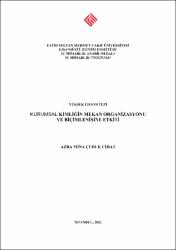Kurumsal Kimliğin Mekan Organizasyonu ve Biçimlenişine Etkisi
Citation
CİHAT, Azra Mina ÇUBUK, Kurumsal Kimliğin Mekan Organizasyonu ve Biçimlenişine Etkisi, Fatih Sultan Mehmet Vakıf Üniversitesi Lisansüstü Eğitim Enstitüsü İç Mimarlık Anabilim Dalı İç Mimarlık Programı,Yayımlanmamış Yüksek Lisans Tezi, İstanbul 2022.Abstract
Kurumsal tasarım kuruma ait tüm değerleri, kurumun tarihini, kültürünü, felsefesini, misyon ve vizyonunu, imajını görsel ve işitsel yollarla yansıtmak üzere planlanan çok boyutlu bir kavramdır. Kurumlar etkili bir kurumsal kimlik oluşturarak iletişim halinde olduğu birimlere kurumu tüm yönleriyle sunmayı arzular. Bu iletişimin en etkili yolu görsel tasarım elemanlarını mekânsal deneyim içerisinde hedef kitle ile buluşturmaktır. Bu çerçevede kurumsal mekan tasarımı yapılırken kurumsal kimliğin unsurları tasarıma yön veren belirleyici donelerdir.
Bu çalışmada kurumsal kimlik kavramının mekan tasarımını ve plan şemasını nasıl şekillendirdiği araştırılmıştır. Kurumsal kimliğin mekan organizasyonu ve biçimlenişine etkileri dört bölümde ele alınmıştır.
Giriş bölümünde çalışmanın, amacı kapsamı ve yöntemi açıklanmıştır.
Çalışmanın birinci bölümünde kurumsal kimliğin tanımı, ortaya çıkmasındaki temel nedenler belirtilmiştir. Kurumsal kimliğin ortaya çıktığı dönemden günümüze kadar ki süreç içerisinde geçirdiği evleler işlenmiştir. Dünya’daki ve Türkiye’deki tarihsel gelişimi anlatılmış, dönemin önemli örnekleri ile desteklenmiştir.
İkinci bölümde kurumsal kimlik yapısını meydana getiren unsurlar ortaya konmuştur. Kurumsal kimliğin yapısını oluşturan kurum kültürü, kurum felsefesi, kurum misyonu ve vizyonu, kurumsal davranış ve kurumsal imaj kavramları tanımlanmıştır.Üçüncü bölümde kurumsal kimliğin tasarım süreci anlatılmış; kurumsal tasarım elemanları (kurum ismi, logo, tipografi, renk, ürün, ambalaj, koku ve mekân) açıklanmıştır. Tüm başlıklar ile ilgili temel tasarım prensipleri ortaya konmuştur. Kurumsal mekân tasarımı yapı kimliği, iç mekân tasarımı, mekânlar arası ilişki, cephe ve vitrin tasarımı olmak üzere farklı boyutlarıyla ele alınmıştır.
Dördüncü bölümde konuyu somut olarak ele almak için kurumsal kimliğin mekân organizasyonu ve biçimlenişine etkileri Vakko, Google ofisleri ve Garanti Bankası kurumları üzerinden incelenmiştir. Farklı hizmet sektörlerinden seçilen örnekler mimari ve iç mimari açıdan analiz edilmiştir.
Sonuç bölümünde kurum yapısını oluşturan kurum kültürü, imajı ve görsel tasarım elemanlarının kurumsal mekân tasarımı ile nasıl bütünleştirilmesi gerektiği üzerinde durulmuştur. Kurumsal yapıyı yansıtan kuruma özgü tasarlanan mekânların, kurumsal başarıya olumlu etkileri ortaya konmuştur. Tüm çalışma boyunca ele alınan kurumsal tasarım öğelerinin örnekler üzerinden mekâna yansımaları değerlendirilmiştir. Değerlendirme sonucunda olumlu ve olumsuz eleştirilerde bulunulmuştur. Corporate design is a multidimensional concept that is planned to reflect all the values of the institution, its history, culture, philosophy, mission and vision, image through visual and auditory means. Institutions want to present the institution with all its aspects to the units they are in contact with by creating an effective corporate identity. The most effective way of this communication is to bring together the visual design elements with the target audience within the spatial experience. In this framework, while designing the corporate space, the elements of the corporate identity are the determining data that directs the design.
In this study, it has been investigated how the concept of corporate identity shapes the space design and plan scheme. The effects of corporate identity on spatial organization and formation are discussed in four sections.
In the introduction, the aim, scope, and method of the study are explained.
In the first part of the study, the definition of corporate identity and the main reasons for its emergence are stated. The houses that the corporate identity has lived in from the time it emerged to the present are processed. Its historical development in the world and in Turkey is explained and supported by important examples of the period.
In the second part, the elements that make up the corporate identity structure are revealed. The concepts of corporate culture, corporate philosophy, corporate mission and vision, corporate behavior, and corporate image, which constitute the structure of corporate identity, are defined.
In the third chapter, the design process of corporate identity is explained; corporate design elements (corporate name, logo, typography, color, product,packaging, fragrance, and space) are explained. Basic design principles related to all titles have been revealed. Institutional space design has been handled with different dimensions such as building identity, interior design, relationship between spaces, facade, and showcase design.
In the fourth chapter, the effects of corporate identity on spatial organization and formation were examined through Vakko, Google offices and Garanti Bank institutions to deal with the subject concretely. Samples selected from different service sectors were analyzed in terms of architecture and interior architecture.
In the conclusion part, it is emphasized how the corporate culture, image and visual design elements that make up the corporate structure should be integrated with the corporate space design. The positive effects of the spaces designed specifically for the institution, reflecting the institutional structure, on corporate success have been revealed. The reflections of the corporate design elements discussed throughout the study on the space were evaluated through examples. As a result of the evaluation, positive and negative criticisms were made.



















